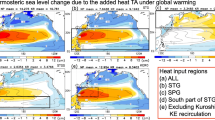Abstract
Future sea level rise from thermal expansion of the World Ocean due to global warming has been explored in several recent studies using coupled ocean-atmosphere models. These coupled models show that the heat input by the model atmosphere to the ocean in such an event could be quite non-uniform in different areas of the ocean. One of the most significant effects predicted by some of the models is a weakening of the thermohaline circulation, which normally transports heat poleward. Since the greatest heat input from enhanced greenhouse warming is in the higher latitudes, a weakening of the poleward heat transport effectively redistributes the heat anomaly and the associated sea level rise to lower latitudes. In this study, the mechanism of ocean circulation spindown and heat redistribution was studied in the context of a much simpler, linearized shallow water model. Although the model is much simpler than the three-dimensional ocean circulation models used in the coupled model experiments, and neglects several important physical effects, it has a nearly 10-fold increase in horizontal resolution and clearer dynamical interpretations. The results indicated that advanced signals of sea level rise propagated rapidly through the action of Kelvin and Rossby waves, but the full adjustment toward a more uniform sea level rise took place much more slowly. Long time scales were required to redistribute mass through narrow currents trapped along coasts and the equatorial wave guide. For realistic greenhouse warming, the model showed why the sea level rise due to ocean heating could be far from uniform over the globe and hence difficult to estimate from coastal tide gauge stations.
Similar content being viewed by others
References
Bryan K (1996) The steric component of sea level rise associated with enhanced greenhouse warming: a coupled GCM study. Clim Dyn (this issue)
Bryan K, Komro FG, Rooth C (1984) The ocean's transient response to global surface temperature anomalies. In: Climate processes and climate sensitivity, Geophysical Monograph 29, Maurice Ewing Volume 5, pp. 29–38
Crank J (1975) The mathematics of diffusion. Clarendon Press, Oxford, 2nd Edn.
Gill AE (1976) Adjustment under gravity in an rotating channel. J Fluid Mech 77:603–621
Gill AE (1982) Atmosphere-ocean dynamics. Academic Press, Orlando, USA
Hsieh WW, Gill AE (1984) The Rossby adjustment problem in a rotating, stratified channel, with and without topography. J Phys Oceanogr 14:424–437
Hsieh WW, Davey MK, Wajsowicz RC (1983) The free Kelvin wave in finite-difference numerical models. J Phys Oceanogr 13:1383–1397
Kawase M (1987) Establishment of deep ocean circulation driven by deep-water production. J Phys Oceanogr 17:2294–2317
Manabe S, Stouffer RJ, Spelman M, Bryan K (1991) Transient responses of a coupled ocean-atmosphere model to gradual changes of atmospheric carbon-dioxide, Part I: annual mean response. J Clim 4:785–818
Ng M, Hsieh WW (1994) The equatorial Kelvin wave in finite-difference models. J Geophys Res 99:14173–14185
O'Brien JJ, Parham F (1992) Equatorial Kelvin waves do not vanish. Mon Weather Rev 120:1764–1766
Philander SG (1990) El Nino, La Nina, and the Southern Oscillation. Academic Press. San Diego, USA
Sadourny R (1975) Compressible model flow on the sphere. J Atmos Sci 32:2103–2110
Stommel H, Arons AB (1960a) On the abyssal circulation of the world ocean — I. Stationary planetary flow patterns on a sphere. Deep Sea Res 6:140–154
Stommel H, Arons AB (1960b) On the abyssal circulation of the world ocean — II. An idealized model of the circulation pattern and amplitude in oceanic basins. Deep Sea Res 6:217–233
Wajsowicz RC (1986) Adjustment of the ocean under buoyancy forces. Part II: the role of planetary waves. J Phys Oceanogr 16:2115–2136
Wajsowicz RC, Gill AE (1986) Adjustment of the ocean under buoyancy forces. Part I: the role of Kelvin waves. J Phys Oceanogr 16:2097–2114
Warrick R, Oerlemans J (1990) Sea level rise. In: Climate change: the IPCC Assessment, pp 261–279
Author information
Authors and Affiliations
Rights and permissions
About this article
Cite this article
Hsieh, W.W., Bryan, K. Redistribution of sea level rise associated with enhanced greenhouse warming: a simple model study. Climate Dynamics 12, 535–544 (1996). https://doi.org/10.1007/BF00207937
Received:
Accepted:
Issue Date:
DOI: https://doi.org/10.1007/BF00207937




